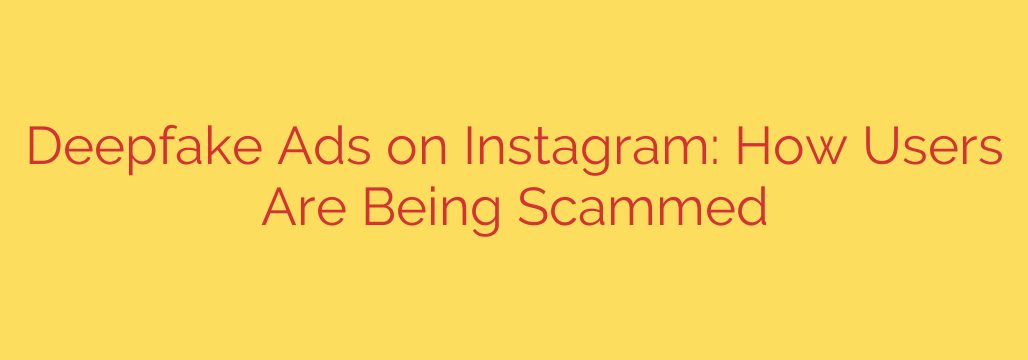
The New Threat in Your Feed: How Deepfake Scams on Instagram are Fooling Millions
You’re scrolling through your Instagram feed, catching up on friends’ stories and your favorite creators, when an ad pops up. It’s a well-known public figure—perhaps a tech billionaire or a famous influencer—endorsing a groundbreaking new product or a can’t-miss investment opportunity. Their voice is familiar, their face is recognizable, and the offer sounds incredible. But before you click, you need to ask yourself: is that person really them?
Increasingly, the answer is no. We are witnessing the rise of a sophisticated and dangerous new threat: AI-generated deepfake scams. These are not just harmless memes; they are malicious advertisements designed to exploit your trust and steal your money or personal information.
What Are Deepfake Ads and Why Are They So Deceptive?
A deepfake is a video or audio clip that has been manipulated using artificial intelligence (AI) to convincingly replace a person’s likeness with someone else’s. The technology has become so advanced that it can realistically mimic a person’s facial expressions, voice, and mannerisms.
Scammers are now weaponizing this technology to create ads featuring celebrities and respected public figures. By using a trusted face, they bypass our natural skepticism. An ad featuring Elon Musk promoting a crypto giveaway or MrBeast offering a new gadget for free feels more legitimate than one from an unknown brand. This false endorsement is the key to the scam’s success.
The Anatomy of a Deepfake Scam
The process is designed to be seamless and persuasive, guiding you from your social media feed to a financial loss in just a few clicks.
- The Ad: A deepfake video appears as a sponsored post or Reel on Instagram. It often promises exclusive access to high-return investments, free high-value products, or government-backed financial aid programs.
- The Hook: The deepfake celebrity urges you to act quickly, creating a sense of urgency and scarcity. They might say things like “spots are limited” or “this offer ends today.”
- The Landing Page: Clicking the link in the ad takes you to a professional-looking but fraudulent website. This site is designed to mimic a legitimate news outlet, financial institution, or official product page.
- The Theft: You are then prompted to enter your personal and financial information—such as your name, email, phone number, and credit card details—to “register” or “claim your prize.” Once you provide this data, it goes directly to the scammers.
The result can be immediate financial theft, identity fraud, or being signed up for recurring subscription charges that are nearly impossible to cancel.
How to Spot a Deepfake Ad: Key Warning Signs
While deepfake technology is improving, it isn’t perfect. With a careful eye, you can often spot the signs of a fake.
- Awkward Lip-Syncing or Voice: The audio might not perfectly match the movement of the person’s lips. The voice itself could sound robotic, have an unusual cadence, or lack natural emotional inflection.
- Unnatural Facial Movements: Look for strange blinking patterns (either too much or not at all), awkward smiles, or stiff head and neck movements. AI can struggle to replicate these subtle human behaviors perfectly.
- Visual Distortions: Pay close attention to the edges of the person’s face. You might see blurring, flickering, or mismatched skin tones where the deepfake has been layered onto the original video.
- “Too Good to Be True” Offers: This is the oldest rule in the book for a reason. Legitimate celebrities will not contact you through a random Instagram ad to offer you free money or guaranteed investment returns.
- Disabled Comments: Scammers almost always disable the comment section on their ads. This prevents real users from warning others that the ad is a fraud. If you can’t see what other people are saying, be extremely cautious.
How to Protect Yourself and Fight Back
Staying safe requires vigilance and a healthy dose of skepticism. Here are actionable steps you can take to protect yourself from these evolving scams.
- Verify from the Official Source: If an ad features a celebrity, go directly to their verified, official social media profiles. If the offer is legitimate, they will almost certainly be promoting it there. Do not trust the ad itself.
- Never Click Links from Suspicious Ads: It’s best to avoid interacting with the ad altogether. Do not provide any personal information on a website you arrived at from an ad, especially one that seems suspicious.
- Scrutinize the URL: If you do click, examine the website address. Scammers often use URLs that are slight misspellings of legitimate sites (e.g., “WallStretJournal” instead of “WallStreetJournal”).
- Use Strong, Unique Passwords and Two-Factor Authentication (2FA): This won’t stop you from seeing a scam ad, but it can protect your accounts if your data is ever compromised.
- Report the Ad: This is a crucial step in protecting the community. If you see a suspicious ad on Instagram, click the three dots (…) in the corner of the post, select “Report,” and choose “It’s a scam or fraudulent.” The more users report these ads, the faster they can be removed.
The digital landscape is constantly changing, and bad actors will always look for new ways to exploit technology. By staying informed and cautious, you can learn to spot these deceptive deepfake ads and keep your personal and financial information secure.
Source: https://www.kaspersky.com/blog/scam-with-deepfakes-in-instagram-facebook-whatsapp/54025/








